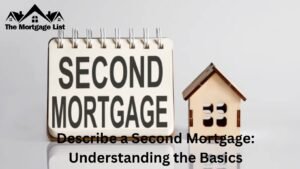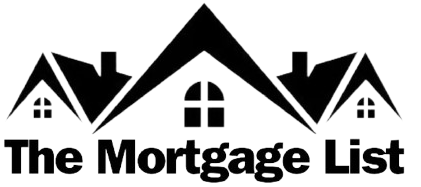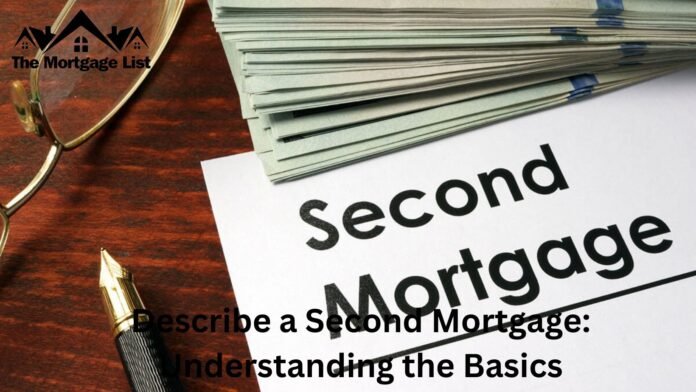Describe a Second Mortgage
Second mortgages can be a valuable financial tool for homeowners looking to access additional funds for various purposes. They allow individuals to borrow against the equity in their homes, providing flexibility and relatively low-interest rates compared to other forms of borrowing. In this comprehensive guide, we’ll explore the ins and outs of second mortgages, including their types, advantages, considerations, application process, risks, alternatives, and smart ways to utilize them.
Introduction to Second Mortgage
Definition and Purpose
A second mortgage, also known as a home equity loan or line of credit, is a loan taken out against the equity in a property that already has a primary mortgage. The equity represents the difference between the current market value of the property and the outstanding balance on the primary mortgage. Second mortgages are often used for major expenses such as home renovations, debt consolidation, or funding education.
How Second Mortgages Work
When a homeowner applies for a second mortgage, the lender evaluates the property’s value and the amount of equity available. If approved, the borrower receives a lump sum (for a home equity loan) or a line of credit (for a HELOC) based on the equity. The borrower then makes regular payments to repay the loan, typically over a fixed term with a predetermined interest rate.

Types of Second Mortgages
Home Equity Loans
A home equity loan provides a lump sum payment upfront, which the borrower repays over time with a fixed interest rate. This type of second mortgage is ideal for borrowers who prefer predictable monthly payments and need a specific amount of funds for a one-time expense.
Home Equity Lines of Credit (HELOC)
A HELOC operates more like a credit card, allowing borrowers to access funds as needed up to a predetermined credit limit. Borrowers can withdraw and repay funds multiple times during the draw period, usually 5 to 10 years, after which they enter the repayment period. HELOCs typically have variable interest rates tied to the prime rate.
Advantages of Second Mortgages
Access to Funds
Second mortgages provide homeowners with a convenient way to access a large sum of money without selling their homes. This can be particularly beneficial for financing home improvements, covering unexpected expenses, or consolidating high-interest debt.
Lower Interest Rates
Since second mortgages are secured by the property, they often come with lower interest rates compared to unsecured loans like credit cards or personal loans. Additionally, the interest paid on a second mortgage may be tax-deductible, further reducing the overall cost.
Tax Deductibility
In many cases, the interest paid on a second mortgage may be tax-deductible if the funds are used for home improvements. This can result in significant savings for homeowners, making second mortgages an attractive financing option.

Considerations Before Getting a Second Mortgage
Equity Requirements
Lenders typically require a minimum amount of equity in the property to qualify for a second mortgage. The exact requirements vary depending on the lender and the type of loan, but borrowers should have sufficient equity to cover the loan amount they’re seeking.
Impact on Credit Score
Taking out a second mortgage can affect the borrower’s credit score, particularly if it increases their overall debt-to-income ratio. It’s essential to consider the potential impact on creditworthiness before applying for a second mortgage.
Repayment Terms
Borrowers should carefully review the repayment terms of a second mortgage, including the interest rate, monthly payments, and any fees associated with the loan. It’s crucial to ensure that the terms are manageable and align with the borrower’s financial goals.
Steps to Obtain a Second Mortgage
Assessing Equity
Before applying for a second mortgage, homeowners should assess their equity position by obtaining a current appraisal of their property. This will help determine the maximum amount they can borrow and ensure that they meet the lender’s equity requirements.
Researching Lenders
It’s essential to shop around and compare offers from multiple lenders when considering a second mortgage. Borrowers should look for reputable lenders with competitive interest rates, favorable terms, and excellent customer service.
Application Process
The application process for a second mortgage typically involves providing financial documentation, such as income verification, credit history, and details about the property. Once the application is submitted, the lender will review the information and determine whether to approve the loan.
Risks of Second Mortgages
Risk of Foreclosure
Since second mortgages are secured by the property, failure to repay the loan could result in foreclosure, leading to the loss of the home. Borrowers should carefully consider their ability to make payments before taking out a second mortgage.
Variable Interest Rates
HELOCs often come with variable interest rates, which can fluctuate over time based on market conditions. This can result in unpredictable monthly payments, making it essential for borrowers to budget accordingly.
Overleveraging
Taking out a second mortgage can increase the borrower’s overall debt burden, potentially leading to financial strain if they’re unable to manage the payments. It’s crucial to borrow responsibly and only take out a second mortgage if it aligns with long-term financial goals.
Alternatives to Second Mortgages
Personal Loans
Personal loans are unsecured loans that can be used for various purposes, including home improvements, debt consolidation, or emergency expenses. While they typically have higher interest rates than second mortgages, personal loans may be a suitable alternative for borrowers who don’t want to use their home as collateral.
Refinancing
Refinancing involves replacing an existing mortgage with a new loan, often with more favorable terms or a lower interest rate. Cash-out refinancing allows homeowners to borrow additional funds beyond the balance of their existing mortgage, providing an alternative to second mortgages.
How to Use a Second Mortgage Wisely
Debt Consolidation
Consolidating high-interest debt with a second mortgage can help borrowers save money on interest and simplify their finances by combining multiple payments into one. However, it’s essential to avoid accumulating new debt and commit to repaying the loan on time.
Home Improvement Projects
Using a second mortgage to fund home improvements can increase the property’s value and enhance its appeal. Whether it’s renovating the kitchen, adding a bathroom, or updating the landscaping, investing in home improvements can pay off in the long run.

Education Expenses
Second mortgages can also be used to cover education expenses, such as tuition, books, and living expenses. While student loans may offer more favorable terms for educational purposes, a second mortgage can provide an alternative source of funding for homeowners.
Conclusion
In conclusion, a second mortgage can be a valuable financial tool for homeowners seeking to access funds for various purposes. Whether it’s home improvements, debt consolidation, or education expenses, second mortgages offer flexibility, lower interest rates, and potential tax benefits. However, it’s essential to carefully consider the risks and alternatives before taking out a second mortgage and use the funds wisely to achieve long-term financial goals.
FAQs
- Are second mortgages a good idea?
- Second mortgages can be beneficial for homeowners who need access to funds for specific purposes, but they also come with risks. It’s essential to weigh the pros and cons carefully and consider alternatives before proceeding.
- What are the main differences between a home equity loan and a HELOC?
- A home equity loan provides a lump sum payment upfront with a fixed interest rate and fixed monthly payments, while a HELOC operates more like a line of credit with a variable interest rate and flexible draw period.
- How does a second mortgage affect my taxes?
- The interest paid on a second mortgage may be tax-deductible if the funds are used for home improvements. However, borrowers should consult with a tax advisor to understand the specific implications for their situation.
- Can I get a second mortgage with bad credit?
- While it may be more challenging to qualify for a second mortgage with bad credit, some lenders offer specialized programs for borrowers with less-than-perfect credit histories. However, borrowers may face higher interest rates and stricter eligibility requirements.
- What happens if I can’t make payments on my second mortgage?
- If you’re unable to make payments on your second mortgage, you could risk foreclosure, leading to the loss of your home. It’s crucial to communicate with your lender and explore options for assistance or refinancing if you’re facing financial difficulties.
Read More:>

